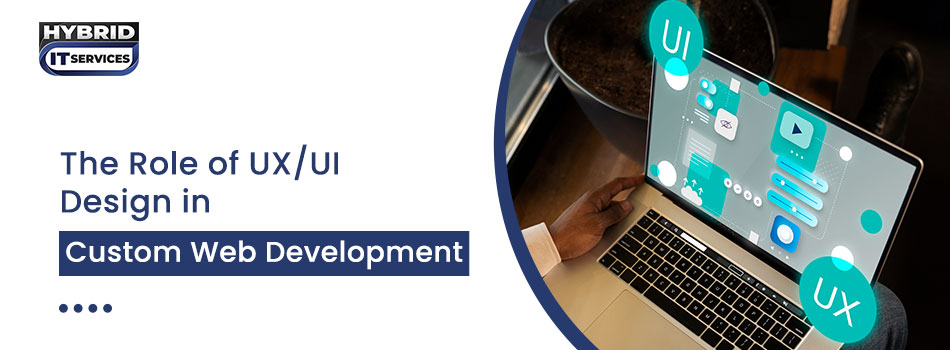A website is often the first point of contact between a business and its customers. This initial interaction can set the tone for the entire customer experience, making it crucial for the website to be both visually appealing and easy to navigate. This is where User Experience (UX) and User Interface (UI) design come into play. In this article, we will explore the significant role of UX/UI design in custom web development, breaking it down into key perspectives to provide a comprehensive understanding.
Understanding UX and UI Design
Before diving into their role in web development, it's essential to understand what UX and UI design entail:
User Experience (UX): This focuses on the overall feel of the website. It involves research and planning to ensure the website meets the needs and expectations of users. UX design is about making the user's journey through the website smooth and intuitive.
User Interface (UI): This deals with the visual elements of the website, such as layout, colors, buttons, and typography. UI design is about making the website aesthetically pleasing and interactive.
The Importance of UX/UI in Custom Web Development
Let’s see the importance of UX in web design:
Enhancing User Satisfaction
A well-designed website ensures that users can easily find what they are looking for. When a website is easy to navigate and visually appealing, users are more likely to stay longer, explore more pages, and engage with the content. This leads to higher user satisfaction and increases the likelihood of conversions, whether that means making a purchase, signing up for a newsletter, or contacting the business.
Building Brand Credibility and Trust
First impressions matter. A professionally designed website helps build credibility and trust with users. If a website looks outdated or is difficult to use, potential customers may question the legitimacy of the business. A modern, well-designed website conveys professionalism and reliability, helping to establish a strong brand identity.
Improving Accessibility
Good UX/UI design ensures that the website is accessible to all users, including those with disabilities. This involves incorporating features such as alternative text for images, keyboard navigation, and screen reader compatibility. Accessibility is not only a legal requirement in many places but also expands the potential user base, making the website more inclusive.
Boosting SEO Performance
Search engines like Google take user experience into account when ranking websites. UX/UI Design in Custom Web Development with fast loading times, mobile responsiveness, and easy navigation can significantly improve SEO performance. Higher search engine rankings lead to increased visibility and more organic traffic.
Facilitating Data-Driven Decisions
UX/UI design is not just about aesthetics; it's also about functionality and performance. By analyzing user behavior and feedback, businesses can make data-driven decisions to continually improve their website. Tools like heatmaps, user surveys, and A/B testing can provide valuable insights into how users interact with the site and where improvements can be made.
Encouraging User Engagement
Engagement is a key metric for any website. Interactive elements such as buttons, forms, and animations can enhance user engagement, making the website more dynamic and enjoyable to use. Good UI design encourages users to interact with the site, whether it's through clicking on links, filling out forms, or sharing content on social media.
Steps in the UX/UI Design Process
Research
The first step in the UX/UI design process is research. This involves understanding the target audience, their needs, and their behaviors. It also includes analyzing competitors and identifying best practices in the industry. User personas and journey maps are often created during this phase to guide the design process.
Wireframing and Prototyping
Wireframes are basic sketches of the website's layout and structure. They help designers plan the placement of elements and ensure a logical flow of information. Prototypes are more detailed versions that include interactive elements, allowing designers to test the functionality and usability of the design before final development.
Visual Design
Once the wireframes and prototypes are approved, the visual design phase begins. This involves selecting color schemes, typography, images, and other visual elements. The goal is to create a cohesive and attractive design that aligns with the brand's identity.
Development and Testing
The final design is handed over to developers to bring it to life. This phase involves coding the website and ensuring it is responsive and functional across different devices and browsers. Testing is a critical step to identify and fix any issues before the website goes live.
Launch and Optimization
After thorough testing, the website is launched. However, the UX/UI design process doesn't end here. Continuous monitoring and optimization are essential to ensure the website remains effective and up-to-date. Regular updates based on user feedback and technological advancements help keep the website relevant and user-friendly.
Consider Hybrid IT Custom Web Development Services in Arizona
Hybrid IT Custom Web Development Services in Arizona offer a unique blend of on-premises and cloud-based solutions tailored to meet the diverse needs of businesses. By combining the flexibility and scalability of cloud services with the security and control of local infrastructure, these services ensure optimal performance and reliability. In Arizona, businesses can leverage Hybrid IT's expertise to develop custom web solutions that enhance their digital presence, streamline operations, and drive growth. With a focus on cutting-edge technology and personalized service, Hybrid IT Services stand out as a premier choice for innovative and effective web development.
Conclusion
UX/UI design plays a pivotal role in custom web development, impacting everything from user satisfaction and engagement to brand credibility and SEO performance. By focusing on creating a seamless and enjoyable user experience, businesses can build strong, lasting relationships with their customers. Investing in good UX/UI design is not just about making a website look good; it's about creating a functional, accessible, and effective online presence that meets the needs of its users.






